|
Week 11: October 10 - 16, 2013 |
Welcome
to the McGill Bird Observatory weekly report.
Click here for a complete listing of our archives.
Comments or
questions are welcome at "mbo AT migrationresearch.org".
|
PICTURE
OF THE WEEK: |
|
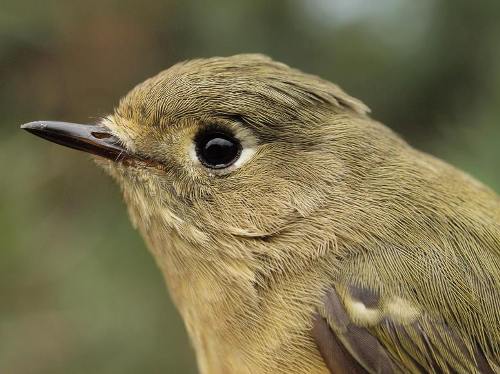
It was a kinglet week at MBO, with this and 60 other Ruby-crowned as well as
31 Golden-crowned banded, plus many more observed.
(Photo by Simon Duval)
-
|
|
|
THIS WEEK |
THIS FALL |
2013 TOTAL |
SITE TOTAL |
|
# birds (and species) banded |
271 (22) |
3037 (75) |
4332 (87) |
45844 (113) |
|
# birds (and species) repeat |
48 (9) |
704 (43) |
1034 (55) |
9015 (70) |
|
# birds (and species) return |
3 (3) |
46 (18) |
201 (35) |
1410 (38) |
|
# species observed |
67 |
143 |
165 |
209 |
|
# net hours |
497.5 |
5725.0 |
9081.8 |
78371.5 |
|
# birds banded / 100 net hours |
54.5 |
53.0 |
47.7 |
58.5 |
|
|
Note: table does not include nocturnal banding (owls) |
|
Banders-in-charge: Simon Duval, Gay Gruner
Assistants: Nicolas Bernier, Sue Bishop, Cindy Bouchard, Marie-France Boudreault, Gabrielle Cottam, David Davey, Jean Demers, Réjean Duval, Barbara Frei, Nathalie Gendron, Alison Hackney, Lisa Keelty, Francine Marcoux, Betsy McFarlane, Catherine Russell, Shawna Sevigny, Ahmad Shah, Clémence Soulard, Jay VanderGaast
Notes: Week 11 usually represents the beginning of late fall at MBO, with numbers tapering off from the traditional late September to early October peak period. That was the case this year, dropping from 483 birds banded last week to 271 this week, a total that is a bit below the 8-year average of 337, but not that far from the middle of the range of 104 to 635 that we've previously recorded during this period. A sharp drop in species diversity is also typical for this time of year, and the 22 species banded this week is fairly average, though the 67 observed was just one below the record of 68 for week 11 way back in 2005, and considerably above the mean of 61.
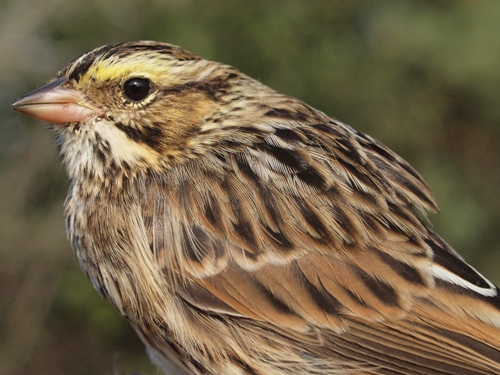
The first Savannah Sparrow banded at MBO in fall since 2008.
(Photo by Simon Duval)
|
Only American Tree Sparrow was newly observed for the season, and we also banded the species. The Savannah Sparrow banded this week was the first one in fall since 2008! We also banded two other species for the first time this fall, despite them being around all season: Hairy Woodpecker and European Starling.
This week’s top 10 [last week's rank in brackets]
# individuals banded |
mean # individuals observed daily |
1. Ruby-crowned Kinglet (61) [1] |
1. Canada Goose (191) [1] |
1. White-throated Sparrow (61) [2] |
2. American Robin (157) [3] |
3. American Robin (32) [4] |
3. Red-winged Blackbird (99) [9] |
4. Golden-crowned Kinglet (30) [5] |
4. European Starling (84) [8] |
5. Slate-colored Junco (21) [7] |
5. American Crow (72) [4] |
6. Yellow-rumped Warbler (13) [3] |
6. Common Grackle (69) [2] |
7. Song Sparrow (12) [6] |
7. White-throated Sparrow (47) [6] |
8. Fox Sparrow (11) [-] |
8. Ring-billed Gull (37) [-] |
9. Hermit Thrush (9) [8] |
9. Blue Jay (26) [7] |
10. Downy Woodpecker (3) [-]
10. Blue Jay (3) [9]
|
10. Ruby-crowned Kinglet (22) [5]
|
|
This week there was a rare tie for the top number of birds banded, with 61 each of Ruby-crowned Kinglet and White-throated Sparrow. This is the second year in a row that their numbers have been extremely close in week 11 - last year we banded 56 Ruby-crowned Kinglets and 55 White-throated Sparrows during this period. Going back further though, White-throated Sparrow has only one other time been in the top two for week 11, and Ruby-crowned Kinglet just twice over 7 previous years. Perhaps another sign that some birds are migrating a bit later in fall? On the other hand, American Robin was among the top three species banded in week 11 from 2005 through 2009, and has returned to that level this fall after ranking a bit lower the past three years. Golden-crowned Kinglet has only appeared in the week 11 top ten in half of our eight previous seasons, and never in as high numbers as we recorded this week. Slate-colored Junco is a regular at this time of year, and rounded out the top five, although with somewhat below average numbers. Yellow-rumped Warbler numbers tapered off this week, as is typical at MBO in mid-October; the same is true for Hermit Thrush. Song Sparrows continue to be banded in modest but steady numbers, week after week. Fox Sparrows are one of MBO's late fall specialties, and it seems this year they are arriving in good numbers somewhat earlier than usual. A few Downy Woodpeckers and Blue Jays rounded out this week's top ten.
This marks the fourth time that Canada Geese have been the most abundant birds observed in week 11. American Robin has also taken top spot four times, and this year was the runner-up by a relatively small margin. The only other species that has previously dominated week 11 is Common Grackle, which this week appeared in fairly modest numbers, an average of 69 per day, mostly a component of mixed blackbird flocks more strongly populated with Red-winged Blackbirds and European Starlings. American Crow was the fourth most abundant species during week 11 for seven years in a row, before dropping to sixth place last year and rebounding to fifth this year. White-throated Sparrow numbers remained high, and marked the fourth year in a row that the species has been the sixth or seventh most abundant species at MBO during week 11. An influx of Ring-billed Gulls this week was surprising, as the species has never before appeared in the top ten for week 11, and the mean number of individuals at this time of year is typically five or fewer. Blue Jays were also more abundant than usual at this time of year, although the mean daily count dropped by nearly ten since last week. Ruby-crowned Kinglets, although they topped the list of species banded this week, were not quite as abundant overall.
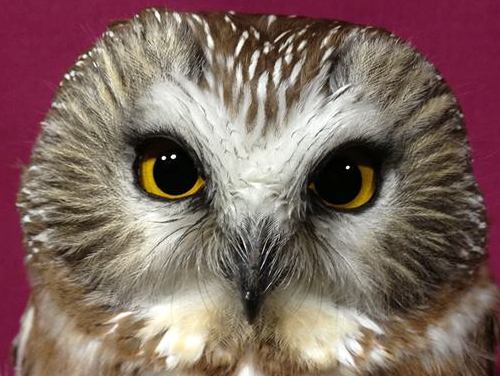
We banded this Northern Saw-whet Owl last week on October 9; only three days later it was recaptured at a banding station in the Adirondacks, 110 km to the south!
(Photo by Nicolas Bernier)
|
Last week ended with our two busiest owling nights of the season to date (20 banded on October 8 and 15 on October 9), and that strong movement continued into the start of this week with another 17 banded on October 10. After that though there was a drop to 7 new owls on October 11, and the count continued to taper off to just a single owl on the final two nights of the week. Overall, there were 42 saw-whets banded this week, bringing our season total to an even 100 - a substantial count given that this is expected to be a low year in the population cycle, and many other banding stations are reporting poor numbers. Just as impressively, we recaptured another 7 foreign-banded owls this week, including a remarkable 5 on the night of October 10. To put this in context, over our previous seven years of owl monitoring, we only had a grand total of 16 foreign recaptures. We don't yet know where most of this week's owls originated, but at least one of them was banded in Virginia.
|
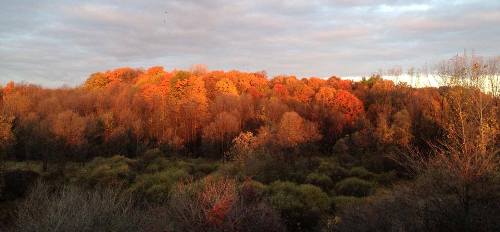
Morning light at MBO.
(Photo by Simon Duval)
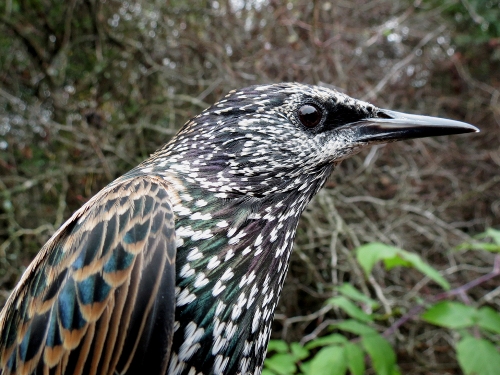
Although an abundant bird, European Starling is rarely banded at MBO - this one was only the fourth ever during the fall season.
(Photo by Gay Gruner)
|





